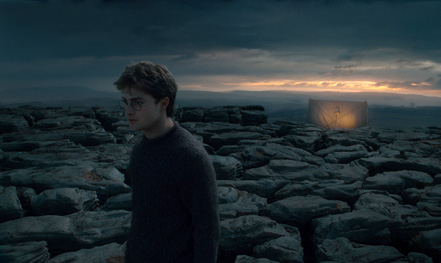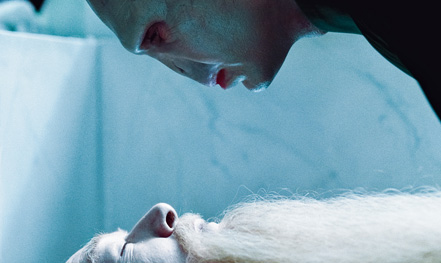Review
Harry Potter and the Deathly Hallows
Part 1

Practical magic and the power of love struggle against great swathes of plot exposition in this near-finale of Warners’ epic J.K. Rowling wizard cycle, says Sophie Mayer
Harry Potter and the Deathly Hallows Part 1
US/UK 2010
Director: David Yates
With Daniel Radcliffe, Rupert Grint, Emma Watson, Helena Bonham Carter, Robbie Coltrane, Warwick Davis, Ralph Fiennes, Michael Gambon, Brendan Gleeson, Richard Griffiths, John Hurt, Jason Isaacs, Alan Rickman, Fiona Shaw, Timothy Spall, Imelda Staunton, David Thewlis, Julie Walters, Bill Nighy
146 mins | Cert 12A
Synopsis
Our synopses give away the plot in full, including surprise twists.
England, the present. Harry Potter’s nemesis Lord Voldemort has taken over the Ministry of Magic. Following attacks by Voldemort’s Death Eaters, Harry and his friends Hermione Granger and Ron Weasley go on the run. They take with them items bequeathed to them by their former headmaster Albus Dumbledore, which they hope will help them in their quest to find the Horcruxes that contain Voldemort’s soul. (Only by destroying the Horcruxes can they hope to destroy Voldemort.)
The trio snatch a Horcrux – a locket – from the Ministry of Magic and disappear into the wild. They try to destroy the locket but are unable to do so. Affected by the malevolent power of the locket, Ron leaves in a fit of jealousy. Harry and Hermione go to Godric’s Hollow, where Dumbledore once lived, and face Voldemort’s snake-familiar in a fight in which Harry’s wand is broken.
Harry is visited by a Patronus spirit, which guides him to the Sword of Gryffindor, lying at the bottom of a frozen pond. Harry fails to retrieve the sword, but Ron returns and retrieves it, using it to destroy the locket.
The three friends visit eccentric wizard Xenophilius Lovegood, who reveals a clue to Voldemort’s plans in the folktale ‘The Three Brothers’, about powerful gifts given by Death. However, Xenophilius gives Harry away to the Death Eaters, sacrificing him in the hope of saving his daughter Luna, who is being held captive by Voldemort’s followers. The trio are taken to the home of Death Eater Lucius Malfoy. Lucius’s son Draco is unable – or unwilling – to identify Harry, as Hermione has disguised him magically, so Bellatrix Lestrange, another Death Eater, tortures Hermione. Dobby the elf, Harry’s loyal friend, rescues Harry, Hermione, Ron and Luna, but is killed by Bellatrix as they make their escape.
Voldemort learns from Dumbledore’s old friend Gellert Grindelwald that Death’s first gift – the most powerful wand in existence – lies buried with Dumbledore in his tomb. Voldemort blasts open the tomb and claims the wand as his own.
Review
The seventh and final book in J.K. Rowling’s Harry Potter series offers a classic finale in which all the threads, and in particular all the threats that surround the hero, are unleashed to create a seemingly insurmountable crisis. Unable to return to Hogwarts School of Witchcraft and Wizardry, Harry loses contact with the Order of the Phoenix, the group of witches and wizards who have been protecting him, and is pursued ever more balefully by the evil Lord Voldemort. Now in control of the wizarding world, Voldemort is also pursuing a lost object: an elder wand made by Death as a gift for a wizard who thought he had outwitted him.
The wand is the first of the titular Deathly Hallows, revealed in the film in an animated folktale of gorgeous 3D shadow-play whose dark shapes link the figure of Death to the swirling CGI forms of Voldemort’s loyal Death Eaters and the Dementors who tormented Harry in the third film. Rowling’s books are much possessed by death, and none more so than the seventh, which opens with the aftermath of Albus Dumbledore’s death and closes with Voldemort’s desecration of his tomb. A series regular – Mad-Eye Moody – dies in the first 15 minutes, as does Harry’s owl Hedwig; the Minister for Magic is dispatched shortly thereafter. Harry visits his parents’ grave, with its movingly simple stone, and ends the film by burying Dobby the elf shortly after his transformation from zero to hero.

Despite these dramatic incidents tethering a clear theme, and a narrative structure driven by a dual quest, the film never quite thrills. Director David Yates faces the daunting challenge of dramatising huge swathes of exposition, as Rowling uses the first half of Deathly Hallows to lay all the pieces – Hallows, Horcruxes, Dumbledore’s bequests, not to mention shifting allegiances (and wands) – in place for the final confrontation. Rather than taking time to wonder, to immerse, or even to grieve at the crucial moments of the story, the film and its characters are driven on towards this future confrontation with videogame logic and an endless flow of exposition-based dialogue.
After delivering what is simultaneously an immense deductive leap and a bald piece of exposition, Hermione responds to Harry’s compliment on her brilliance by pointing out that she is simply being extremely logical (a post-feminist trait also seen in Dana Scully and Star Trek’s Seven of Nine). Her logic underlines Rowling’s practical magic, which springs from a combination of the pragmatic reasoning in folktales and the mathematical, deductive approach of alchemy: there is none of the deeper illogic of the truly fantastic operating here, except for the power of love.
Yates hints at the coming contest between love and death (as good and bad magic) in small moments such as Hermione’s instinctual ‘disapparation’ (teleportation) to the Forest of Dean, which she once visited with her parents. Liberated from Hogwarts, the film also travels to the awesome limestone pavement of Malham Cove in the Yorkshire Dales. There is magic in such locations, which make the characters seem small, and imply the absolute threat Voldemort represents, revealed just after Harry lays aside his wand to bury Dobby.
The Golden Snitch left by Dumbledore to Harry bears the words “opens at the close”. The same is true of the film’s story – not only for the lightning-bolt revelation of Voldemort’s power that comes at the end, but also Harry’s realisation that he (and the filmmakers) will need more than a wand (or special effects) to escape the deadly, and deadening, trap of the final confrontation.
See also
Harry Potter and the Goblet of Fire reviewed by Jonathan Barnes (January 2006)
Back to school: Andrew Roberts looks back at 70 years of UK boarding-school movies (August 2007)
Cherrybomb reviewed by Lisa Mullen (May 2010)
Spirited Away reviewed by Andrew Osmond (September 2003)
